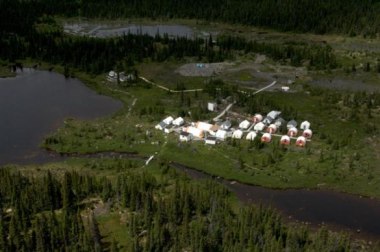Labrador uranium moratorium lifted
15 December 2011
The Nunatsiavut Assembly has voted unanimously to lift a moratorium on the development of uranium deposits on Labrador Inuit lands. As a result, exploration activities are likely to start in earnest by mid-2012.
 |
Aurora's camp at Michelin
(Image: Aurora) |
The vote by the regional Inuit government within the Canadian province of Newfoundland and Labrador is the culmination of a review process that began in September and has involved public consultations across the autonomous region. "The general consensus… is that the moratium should be lifted to allow any proposed development to proceed to environmental assessment," Nunatsiavut minister of lands and natural resources Glen Sheppard declared.
The Nunatsiavut government was established in 2005 and imposed the moratorium in April 2008 to provide sufficient time to make an informed decision on the matter, according to Sheppard. In the meantime, a lands administration system and environmental protection legislation have been drawn up. The moratorium was imposed through an amendment to the Labrador Inuit Lands Act, and must be lifted by another amendment to the act. Such an amendment will not come into effect before Nunatsiavut's environmental protection act comes into force on or before 9 March 2012.
Australia's Paladin Energy holds title to significant uranium assets in the region, including the Michelin and Jacques Lake uranium deposits, through its subsidiary Aurora Energy. The company greeted the Nunatsiavut announcement by saying it would be planning an exploration program for mid-2012, assuming no impediments from the federal or provincial governments. Infill and extension drilling of the Michelin mineralisation is expected to start in the third quarter of the 2012 financial year.
Five of the company's six uranium deposits in eastern Canada's Central Mineral Belt fall within the Labrador Inuit lands. In total, Aurora's holdings have measured resources of 15.1 million pounds U3O8 (5808 tU), indicated resources of 68.7 million pounds U3O8 (26,425 tU) and inferred resources of 53.0 million pounds U3O8 (20,386 tU ) based on NI 43-101 figures published in 2009. In its press release, Paladin said it expects the area to become "the second most important uranium province in Canada and considered to be of worldwide significance."
Researched and written
by World Nuclear News